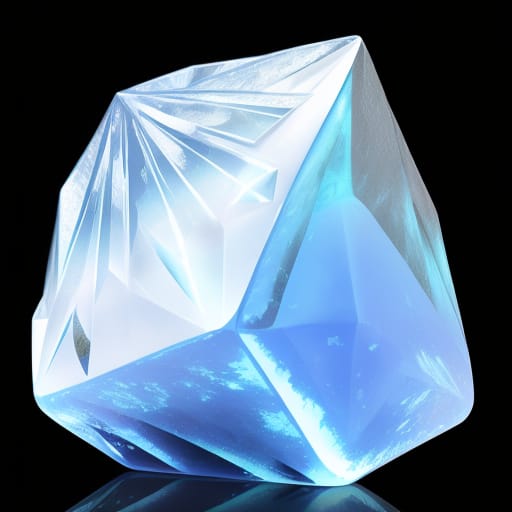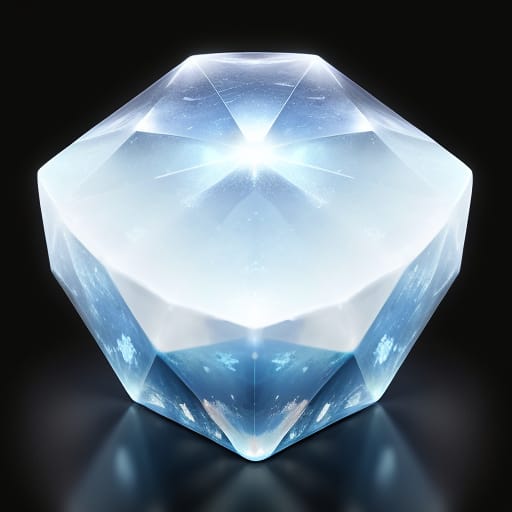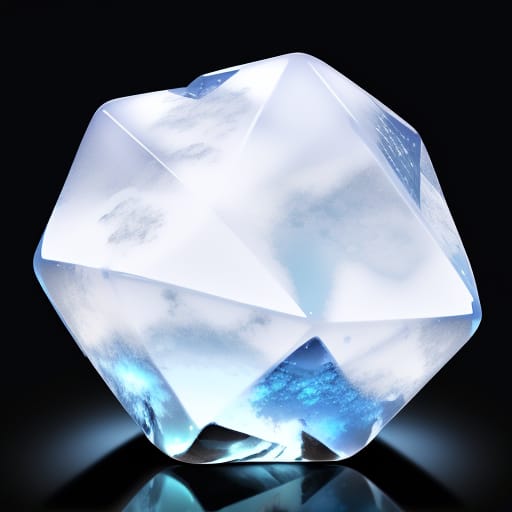Growing borax crystals is a fun science experiment. Kids and adults alike enjoy watching the dazzling, multifaceted crystals form in a borax solution. But sometimes, the beautiful bluish-white crystals you grew turn chalky and white after drying. What causes this whitening? And can you prevent it from happening to your crystals?
In this beginner’s guide, we’ll explore:
- The science behind how borax crystals form
- What causes them to turn white after drying
- Tips to grow clearer crystals and prevent whitening
- How to preserve and protect borax crystals

What Are Borax Crystals?
Borax, also known as sodium borate, is a natural mineral compound. When borax powder is dissolved in hot water, it forms a supersaturated solution. As the solution cools, the excess borax crystallizes out of the water, forming crystals.
Crystal growing is the process of forming a crystalline solid from a solution. As the borax crystals grow, the water molecules arrange themselves in an orderly, geometric pattern that gives crystals their characteristic shape and structure.
Borax crystals have a molecular formula of Na2B4O7•10H2O. They form as hydrated crystals containing water molecules within their crystalline structure.
How Do Borax Crystals Form?
To grow borax crystals, you need just two ingredients: borax powder and water.
Borax powder is dissolved in hot borax solution at a temperature of around 160°F (70°C). This creates a super-saturated borax solution – the water holds more dissolved borax than it would be able to at room temperature.
As the solution cools to room temperature, the excess borax solidifies and crystallizes out of the water. The borax molecules stack together in a repetitive, geometric pattern, forming crystal lattices.
The initial crystals act as seed crystals that help crystallization propagate through the solution. Given enough time, large, multifaceted borax crystals will form.
Why Do Borax Crystals Turn White?
When you first grow borax crystals, they form with a beautiful, clear bluish-white color. The crystals appear glassy and transparent.
But after the crystals fully form and dry out, they often turn into an opaque, chalky white color. What causes this whitening effect?
Loss of Hydration
Freshly grown borax crystals contain water molecules (H2O) within their crystalline structure. This bound water is known as water of crystal hydration.
The molecular formula of borax, Na2B4O7•10H2O, indicates there are 10 water molecules for every molecule of borax. These water molecules are incorporated into the crystal lattice, giving borax its bluish-white translucent appearance.
As crystals dry, they lose their hydrated water over time through a process called efflorescence. The water evaporates from the crystal structure, leaving behind anhydrous borax crystals containing no water of crystallization.
Transition from Borax Dihydrate to Anhydrous Borax
When hydrated borax crystals lose their water content through efflorescence, the crystal structure changes.
Freshly grown crystals are known as borax dihydrate, containing two water molecules per molecule of borax (Na2B4O7•2H2O).
After drying, the crystals transition to anhydrous borax which has no water in its structure (Na2B4O7).
This structural change from a dihydrate to anhydrous form is what causes the whitening of crystals. Anhydrous borax has a different arrangement of molecules that scatter light, making the crystals appear chalky and opaque.
What Factors Cause Borax Crystals to Lose Hydration?
There are a few key factors that impact crystal hydration levels and cause whitening to occur:
Heat
Exposure to heat speeds up the evaporation of water from crystal structures. The higher the temperature, the faster efflorescence occurs.
Storing crystals in hot, dry environments will cause them to lose hydration quickly. Heat accelerates the transition from borax dihydrate to anhydrous borax.
Humidity
Low ambient humidity encourages moisture evaporation from hydrated crystals. Storing crystals in very dry air causes water to be drawn out of the lattice.
Humidity levels impact the rate of efflorescence. Higher humidity slows water loss from the crystals.
Handling
Excessive handling or vibration of growing crystals can cause micro-fractures. These fractures expose more crystal surface area, increasing moisture evaporation.
Gently handling crystals once fully formed reduces physical damage. Limit handling to prevent loss of hydrated water.
Environmental Conditions
Factors like temperature, humidity, air circulation, light exposure, and air pollution all impact crystal hydration.
Pay attention to environmental conditions to minimize efflorescence when growing and storing crystals.
Growing Your Own Borax Crystals
Growing borax crystals is an easy experiment that can be done at home with kids. Here are some tips for your own borax crystal project:
Supplies Needed
- Borax powder
- Distilled water
- Glass jar
- Pipe cleaners or craft sticks
- Food coloring (optional)
Step-by-Step Method
- Make a super saturated borax solution by dissolving 3-4 tablespoons of borax powder per cup of hot distilled water. Stir until fully dissolved.
- Add a few drops of food coloring if desired for colored crystals.
- Tie a pipe cleaner or craft stick to a pencil or pen. Submerge the pipe cleaner in the solution, ensuring 2-3 inches are in the liquid. This acts as a seed crystal.
- Allow the solution to fully cool. Cover the jar and place undisturbed in a location free from vibrations.
- Wait 7-10 days. Borax crystals will begin to form around the pipe cleaner.
- To harvest, gently remove the pipe cleaner. Allow crystals to dry fully in ambient conditions away from direct sunlight.

The Role of Temperature in Crystal Formation
Heating the water helps dissolve more borax powder to create a super-saturated solution. But as the solution cools, borax crystals begin forming through a process called crystallization.
The ideal crystallization temperature is around 60-65°F (15-18°C). Avoid sudden temperature changes – slow cooling results in better crystal formation.
Temperature affects solubility – cooler temperatures mean less borax dissolves in the water, encouraging crystallization. Warm temperatures keep borax dissolved.
How Humidity Impacts Crystal Growth
Evaporation of the solution helps create the super-saturated conditions needed for crystallization. In humid environments, evaporation occurs more slowly.
Humidity also impacts the size of crystals – higher humidity tends to result in larger crystals forming.
Keep the crystallization jar in an area with an average humidity of around 40-60% RH for good crystal growth. Avoid excessively dry or humid conditions.
The Effect of Environmental Conditions on Crystal Color
Thepipe cleaner provides a surface for the crystals to begin forming on. But impurities can impact crystal color and clarity.
Iron, copper, and other metals may be present in water or on surfaces the solution contacts. This can add unintended color.
Environmental conditions like sunlight, temperature, and contamination can all impact the final crystal color. For pure crystal color, use distilled water and clean glassware.
What Causes Changes in Crystal Structure?
Borax forms crystals because the boron, sodium, and oxygen atoms arrange themselves in a repeated fixed pattern. This ordered arrangement is the crystal structure.
Losing water molecules causes structural changes. The crystal transitions from the dihydrate to anhydrous form, changing how the atoms connect.
Exposure to heat or dry conditions removes hydrated water, resulting in an irreversible change to crystal structure.
Preventing Changes to Crystal Structure
To keep borax crystals in their original dihydrate structure:
- Avoid heat over 160°F (70°C) which causes dehydration
- Store crystals at room temperature around 60-75°F (15-24°C)
- Keep ambient humidity between 40-60% RH
- Seal containers to limit air exposure
Slow evaporation and limiting temperature fluctuations preserve the original crystal lattice and structure.
What Causes Borax Crystals to Degrade and Whiten?
There are a few reasons why borax crystals start out clear but then degrade and turn white:
Efflorescence
As borax crystals dry, water evaporates causing efflorescence. This process leaves anhydrous borax crystals with no hydrated water remaining in the structure.
Heat Exposure
Temperatures above 160°F (70°C) accelerate the loss of crystal water. The increased heat changes crystals from borax dihydrate to anhydrous borax.
Humidity Changes
Shifts in ambient humidity impact the rate of efflorescence. Low humidity pulls water from the crystal lattice through evaporation.
Physical Damage
Improper handling like shaking or dropping growing crystals causes fractures and cleaving. These defects increase surface area for moisture loss.
Borax crystal degradation is primarily driven by the loss of hydrated water molecules from the crystalline structure during drying.
Why Do Borax Crystals Turn Opaque and Whiten?
Freshly grown borax crystals are transparent and glassy appearing. But as they transition to anhydrous borax, they turn opaque and chalky white. Here’s why:
- Borax crystal whitening occurs as hydrated water is lost through efflorescence
- Anhydrous borax has a different crystal structure that scatters light
- Loss of water molecules changes the refractive index and opacity
- The ordered crystal lattice becomes disrupted without hydrated water
- Air spaces and fractures form within the crystalline structure
This physical change at the molecular level is why the crystals turn from shiny and clear to dull and white.
How to Prevent Borax Crystal Whitening
To limit whitening and keep borax crystals clear:
- Slowly evaporate the solution to grow crystals – avoid rapid drying
- Maintain an even, ambient temperature of around 60-70°F
- Store crystals at 40-60% relative humidity
- Avoid handling crystals while growing and drying
- Keep borax crystals contained to minimize air exposure
- Use an appropriate crystal preservative spray
Taking steps to prevent dehydration will help maintain crystal clarity and color during the drying process.
Protecting and Preserving Borax Crystals
Borax crystals will gradually lose clarity and turn opaque over time after drying. But there are ways to decelerate degradation and preserve their appearance.
Use a Crystal Preservative Spray
Applying a thin, protective coating helps lock in moisture and prevents efflorescence.
Products like Paraloid B-72, acrylic spray, or polyurethane spray work well. Avoid sprays with color or gloss additives.
Control Storage Temperature and Humidity
Store crystals at around 60-70°F (15-20°C) and 40-60% RH. Avoid large temperature swings or extremely dry conditions. Use desiccant packs to control humidity.
Limit Exposure to Light and Air
Keep borax crystals in a sealed container in cool, dark conditions. Light and airspeed dehydration. Store crystals away from direct sunlight.
Handle Crystals Gently
Avoid unnecessary handling, vibration, and transportation of crystalline specimens. Use soft foam supports inside storage containers.
Careful crystal handling and storage will maximize preservation and extend their visual lifespan.
Troubleshooting Borax Crystals
Growing perfect crystals every time can be tricky. Here are some common borax crystal problems and how to avoid them:
| Issue | Cause | Solution |
|---|---|---|
| No crystals forming | Solution is not super saturated enough | Dissolve more borax powder in hot water |
| Crystals are small | Rapid evaporation | Slowly evaporate solution |
| Crystals are discolored | Contaminants introduced | Use purified water and clean materials |
| Crystals disappear | Temperature too high | Maintain temperature under 160°F (70°C) |
| Crystals turn white | Efflorescence from dehydration | Limit handling and control storage conditions |
| Crystals are brittle | Inadequate moisture while forming | Ensure high humidity during growth |
Troubleshooting crystal issues comes down to carefully controlling crystallization conditions and handling formed crystals with care.
Re-Dissolving and Reforming Borax Crystals
If your borax crystals degrade, it is possible to convert them back into solution for re-crystallization.
Method
- Add your whitened borax crystals to distilled water heated to 160°F (70°C).
- Slowly dissolve the crystals back into saturated solution with constant stirring.
- Allow the solution to cool slowly. Use a seed crystal to encourage recrystallization.
- Given proper time, new borax crystals will grow around the seed crystal.
However, the resulting crystals may be smaller or have altered growth patterns from the original batch. Proper technique is important for crystal reformation.
The Optimal Shape and Size of Borax Crystals
Borax naturally forms into large, multifaceted crystals bounded by flat, symmetrical faces. The ideal shape is an elongated octahedral crystal.
Slow-grown crystals will reach sizes over 1 inch long. Fast evaporation yields smaller crystals. Larger crystals demonstrate more defined geometric faces.
Remove crystals before they fuse together into clusters. Crystal size depends on saturated solution concentration and evaporation rate.
How Does Borax Powder Impact Crystal Growth?
The borax powder should fully dissolve into ionic form in the hot water to create a clear solution.
Undissolved powder provides nucleation points for uncontrolled crystallization. This yields poor crystal shape and opacity.
Using higher purity powder improves crystal clarity. Decanting the solution after cooling leaves behind powder sediment.
Borax powder must be wholly dissolved and the solution left undisturbed for quality crystal growth.

Designing a Borax Crystal Science Experiment
Growing borax crystals makes for an excellent science fair project. Follow the scientific method:
Question
How does borax crystal size vary with solution concentration?
Hypothesis
Higher borax solution concentrations will result in larger crystal size.
Method
- Make 5 borax solutions ranging from 5 to 25 tablespoons borax per cup of water.
- Grow crystals in each solution under controlled conditions.
- Measure and record final crystal sizes after 2 weeks.
Results
Collect measurements of crystal size variation across the different borax concentrations.
Conclusion
Analyze results and conclude if data supports the original hypothesis.
Follow the steps of the scientific method and keep variables controlled for a successfully experiment. Replicate multiple times.
How Does Crystal Density Impact Formation?
The crystal density depends on how closely packed the molecules arrange themselves in the lattice structure. Tight, orderly packing yields dense, flawless crystals.
With rapid crystallization, defects result as molecules do not have time to orient into ideal positions. This lower density leads to poorer optical properties.
Highly dense crystals have fewer gaps or boundaries between molecules to scatter light. Density directly influences crystal clarity.
Key Factors for Quality Crystal Finish
To achieve a smooth, flawless finish:
- Grow crystals slowly from a highly saturated solution
- Maintain constant temperature during crystallization
- Prevent accidental crystal nucleation by avoiding disturbances
- Allow crystals to fully harden before handling
- Use clean tools and proper handling techniques
With care, borax forms beautiful transparent, faceted crystals with a glassy finish.
Properly Handling Borax Crystals
Improperly handling growing or formed crystals causes permanent damage:
- Gently move container to harvest crystals
- Use soft materials like cardboard or foam for storage
- Pick up crystals
Frequently Asked Questions
- How can I make the borax crystals bigger?
Use a highly super saturated solution with more borax powder dissolved. Allow the solution to evaporate slowly and don’t disturb it. Growing larger crystals requires patience.
- What causes the borax crystals to be cloudy?
Cloudy or opaque crystals are caused by crystal degradation as they transition to the anhydrous form. Controlling storage conditions and limiting handling prevents the loss of hydrated water molecules that cause clouding.
- Why are my crystals turning white?
Borax crystal whitening occurs as the crystals lose their hydrated water content through the process of efflorescence. Exposure to heat and low humidity accelerates the whitening effect over time after the crystals are harvested.
- How can I keep the borax crystals blue?
Maintaining proper hydration is key to preserving the crystal color. Use a preservative spray and store the crystals at room temperature with around 40-60% humidity to prevent water loss from the crystalline structure.
- Can I re-grow borax crystals?
Yes, it is possible to re-dissolve degraded crystals to create a super saturated solution again for re-crystallization. Slowly evaporate the solution and use a seed crystal to help the borax form new crystals.
- Why are my crystals shaped weirdly?
The ideal borax crystal shape is an octahedron formed by symmetrical, flat faces. Irregular crystals can form from rapid evaporation or temperature fluctuations during crystal growth. Ensure stable conditions for nicely shaped crystals.
- How do I make colored crystals?
Add a few drops of food coloring to the hot borax solution before crystallization to create colored crystals. Use purified water and avoid contamination for clear, vivid crystal colors.